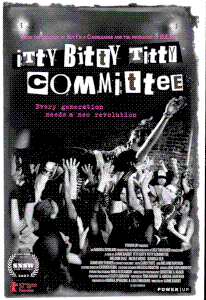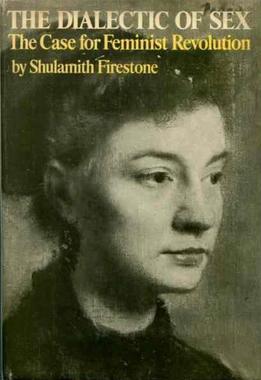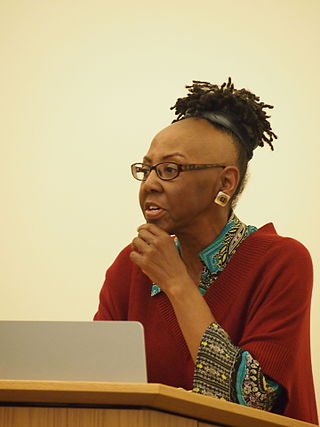Related Research Articles

Shulamith Bath Shmuel Ben Ari Firestone was a Canadian-American radical feminist writer and activist. Firestone was a central figure in the early development of radical feminism and second-wave feminism and a founding member of three radical-feminist groups: New York Radical Women, Redstockings, and New York Radical Feminists. Within these radical movements, Firestone became known as "the firebrand" and "the fireball" for the fervor and passion she expressed towards the cause. Firestone participated in activism such as speaking out at The National Conference for New Politics in Chicago. Also while a member of various feminist groups she participated in actions including protesting a Miss America Contest, organizing a mock funeral for womanhood known as "The Burial of Traditional Womanhood", protesting sexual harassment at Madison Square Garden, organizing abortion speakouts, and disrupting abortion legislation meetings.

Yvonne Rainer is an American dancer, choreographer, and filmmaker, whose work in these disciplines is regarded as challenging and experimental. Her work is sometimes classified as minimalist art. Rainer currently lives and works in New York.
Cyberfeminism is a feminist approach which foregrounds the relationship between cyberspace, the Internet, and technology. It can be used to refer to a philosophy, art practices, methodologies or community. The term was coined in the early 1990s to describe the work of feminists interested in theorizing, critiquing, exploring and re-making the Internet, cyberspace and new-media technologies in general.
The 24th Los Angeles Film Critics Association Awards, honoring the best in film for 1998, were voted on in December 1998. The awards were presented Jan. 20 1999 at the Bel Age Hotel.

Itty Bitty Titty Committee is a 2007 American comedy film directed by Jamie Babbit. It follows the political awakening of Anna, a young, mild-mannered lesbian woman who joins a radical feminist group. The film is produced by non-profit organization POWER UP.
Carol Hanisch is an American radical feminist activist. She was an important member of New York Radical Women and Redstockings. She is best known for popularizing the phrase "the personal is political" in a 1970 essay of the same name. She does not take responsibility of the phrase, stating in her 2006 updated essay, with a new introduction, that did not name it that, or in fact use it in the essay at all. Instead she claims that the title was done by the editors of Notes from the Second Year: Women's Liberation, Shulamith Firestone and Anne Koedt. She also conceived the 1968 Miss America protest and was one of the four women who hung a women's liberation banner over the balcony at the Miss America Pageant, disrupting the proceedings.
New York Radical Feminists (NYRF) was a radical feminist group founded by Shulamith Firestone and Anne Koedt in 1969, after they had left Redstockings and The Feminists, respectively. Firestone's and Koedt's desire to start this new group was aided by Vivian Gornick's 1969 Village Voice article, “The Next Great Moment in History Is Theirs”. The end of this essay announced the formation of the group and included a contact address and phone number, raising considerable national interest from prospective members. NYRF was organized into small cells or "brigades" named after notable feminists of the past; Koedt and Firestone led the Stanton-Anthony Brigade.

New York Radical Women (NYRW) was an early second-wave radical feminist group that existed from 1967 to 1969. They drew nationwide media attention when they unfurled a banner inside the 1968 Miss America pageant displaying the words "Women's Liberation".

The Dialectic of Sex: The Case for Feminist Revolution is a 1970 book by the radical feminist activist Shulamith Firestone. Written over a few months when Firestone was 25, it has been described as a classic of feminist thought.
Anne Koedt is an American radical feminist activist and author of "The Myth of the Vaginal Orgasm", a 1970 classic feminist work on women's sexuality. She was connected to the group New York Radical Women and was a founding member of New York Radical Feminists.

The Miss America protest was a demonstration held at the Miss America 1969 contest on September 7, 1968, attended by about 200 feminists and civil rights advocates. The feminist protest was organized by New York Radical Women and included putting symbolic feminine products into a "Freedom Trash Can" on the Atlantic City boardwalk, including bras, hairspray, makeup, girdles, corsets, false eyelashes, mops, and other items. The protesters also unfurled a large banner emblazoned with "Women's Liberation" inside the contest hall, drawing worldwide media attention to the Women's Liberation Movement.
K8 Hardy is an American artist and filmmaker. Hardy's work spans painting, sculpture, video, and photography and her work has been exhibited internationally at the Whitney Museum of American Art, Tate Modern, Tensta Konsthalle, Karma International, and the Dallas Contemporary. Hardy's work is included in the permanent collections of the Whitney Museum of American Art, the Solomon R. Guggenheim Museum, and the Museum of Modern Art. She is a founding member of the queer feminist artist collective and journal LTTR. She lives and works in New York, New York.

Mira Schor is an American artist, writer, editor, and educator, known for her contributions to critical discourse on the status of painting in contemporary art and culture as well as to feminist art history and criticism.

!Women Art Revolution is a 2010 documentary film directed by Lynn Hershman Leeson and distributed by Zeitgeist Films. It tracks the feminist art movement over 40 years through interviews with artists, curators, critics, and historians.

Woman Hating: A Radical Look at Sexuality is the debut nonfiction book by American radical feminist writer and activist Andrea Dworkin. It was first published in 1974 by E. P. Dutton.
Girl Power is a queer feminist video made in 1992 by Sadie Benning with a Fisher-Price PixelVision camera. The video, which runs for 15 minutes, is considered at once a reflection on Benning's unhappy childhood and a celebration of her sexuality and the Riot grrrl subculture. The video was featured in "Pixel This Vision", a project organized by The Balagan Experimental Film & Video Series to "put together a program of the best of PixelVision"

Michelle Parkerson is an American filmmaker and academic. She is an assistant professor in Film and Media Arts at Temple University and has been an independent film/video maker since the 1980s, focusing particularly on feminist, LGBT, and political activism and issues.

Jennifer Reeder is an American artist, filmmaker, and screenwriter. Her short film A Million Miles Away (2014) was nominated for a Tiger Award for Short Films at the International Film Festival Rotterdam and screened at the 2015 Sundance Film Festival in the U.S. Short Narrative Films category. In 2003, she had a solo screening at Moderna Museet in Stockholm, Sweden. She received a Rockefeller Grant for New Media in 2002 and a Creative Capital grant in 2015 to support the production of her first experimental feature-length film, Knives and Skin. She won a 2018–19 SFFILM Rainin Grant for scriptwriting, and was the 2019 recipient of the Alpert Film Award residency at the MacDowell Colony. In 2021, she was awarded a United States Artists (USA) Fellowship.

Boryana Rossa is a Bulgarian interdisciplinary artist and curator making performance art, video and photographic work.

A Woman, a Part is a 2016 independent drama film, written and directed by Elisabeth Subrin. The story concerns Anna Baskin, a successful yet burnt out actress who absconds from a mind-numbing television role in LA to reinvent herself in NYC, confronting the past and the people she left behind in the process.
References
- Haug, Kate (Nov/Dec, 1998). "Shulie. – Review – video recording reviews", Afterimage.
- Creative Capital (2001): Project Page | UP - Essay "Elisabeth Subrin: Up" (essay), Creative Capital.
- Firestone, Shulamith (1970). "The Dialectic of Sex: The Case for Feminist Revolution", New York: William Morrow and Co.
- Rich, B. Ruby (1998). Chick Flicks: Theories and Memories of the Feminist Film Movement, Durham, North Carolina: Duke University Press.
- Armour, Nicole (Nov/Dec 2000). "Disappearing Acts", Film Comment 36:6.
- Jensen, Jytte (Winter, 2006). "The Colony Gets Its Close-Up", MacDowell, Vol.35, No.2: p. 5.
- Freeman, Elizabeth (2000). "Packing History, Count(er)ing Generations", New Literary History 31:727-744.
- Liehm, Mira (1986). "Passion and Defiance: Italian Film from 1942 to the Present", University of California Press: 230.